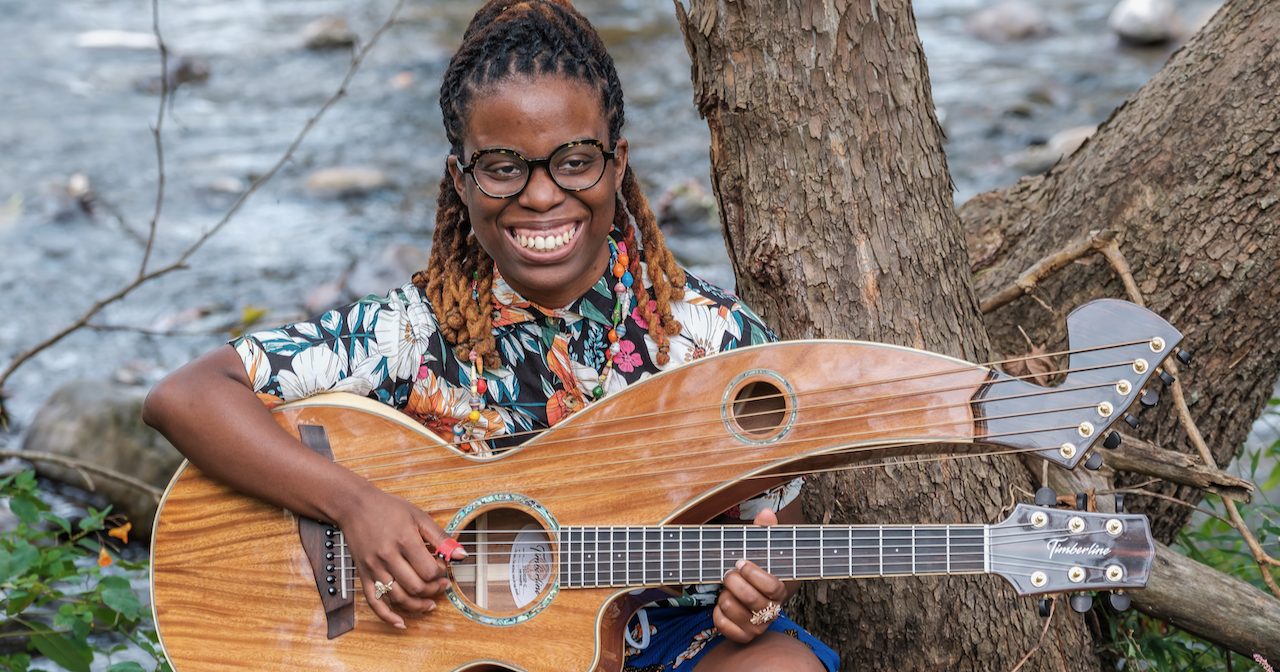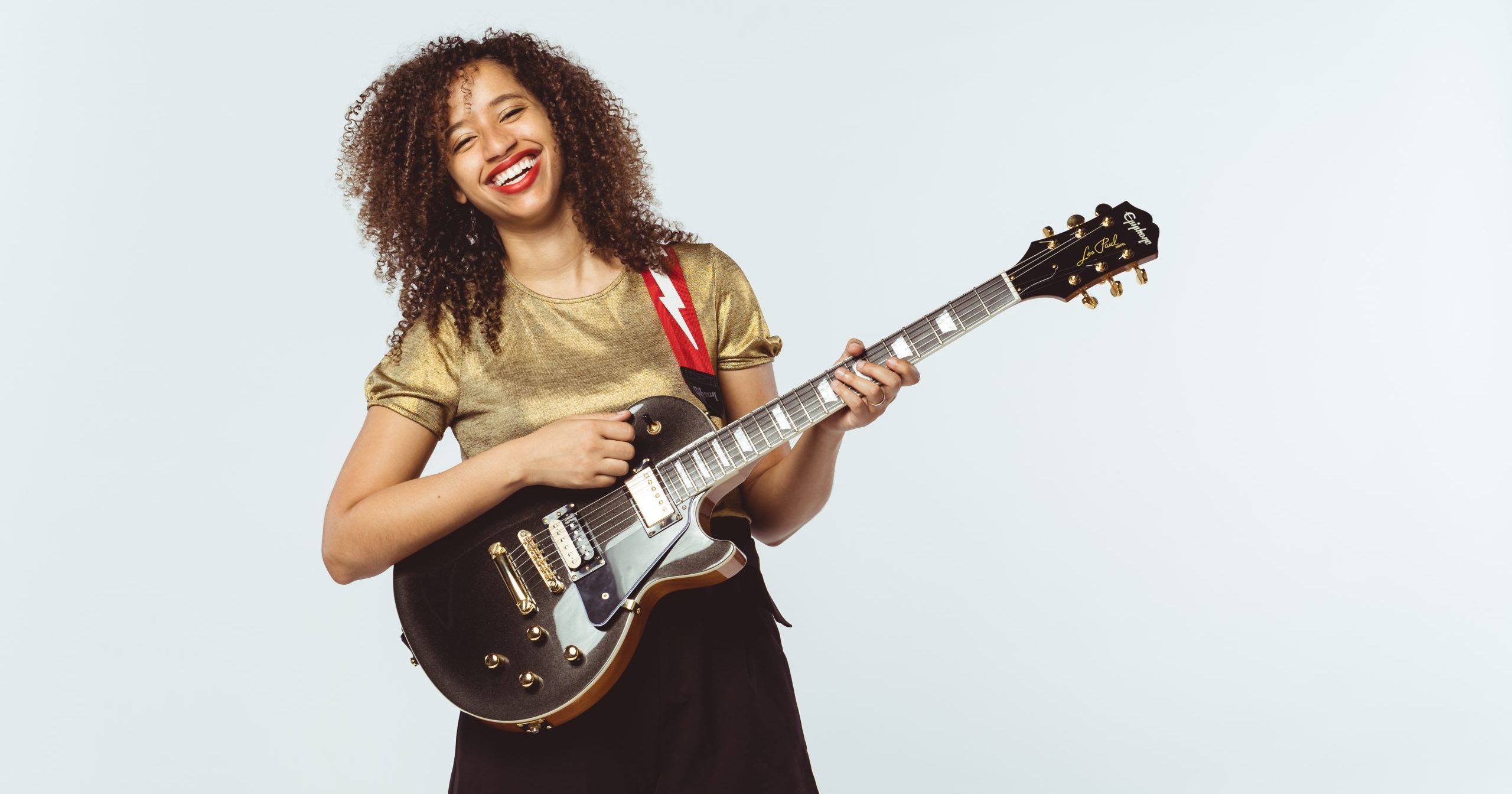Guitarists spend lifetimes — often gleefully, sometimes manically, or at times frustratingly — finessing techniques, especially with their picking hand. Entire careers can be made or broken by the idiosyncrasies of one picker’s striking and sounding strings. Fingerstyle guitarist and composer Yasmin Williams has mastered myriad forms of right-hand styles, each complicated enough for multiple lifetimes’ worth of study. But she doesn’t merely alternate techniques between pieces; to a transcendentally perplexing degree she effortlessly alternates her entire picking hand approach mid-song.
On her 2021 release, Urban Driftwood, a collection of thoughtful, dynamic, and engaging instrumentals written for fingerstyle guitar and harp guitar, Williams makes many of these technique-swaps while the compositions charge forward, each one earning tailor-made right-hand approaches. As a result, the songs don’t feel encumbered when Williams, mid-melody, goes from right hand fingerstyle to bowing her strings with a cello bow, or plunking out notes on a kalimba taped to her guitar’s face, now positioned laying across her lap. She utilizes hand percussion and tap shoes to fill out arrangements, interposing Afro-descended instruments from around the world into her compositions, and she picks up, puts down, and readjusts her stable of musical tools in realtime — as a foley sound effect artist, prop master, or choreographer might.
We began our conversation discussing this phenomenon and how it’s an active, deliberate choice on the part of Williams to serve her own songs.
BGS: There isn’t nearly as much variation in right hand or picking techniques in bluegrass and old-time as you use – tap, lap tapping, fingerstyle, harp guitar, I’ve even seen you bowing your guitar. So many of these contemporary guitar styles that you switch back and forth between are so different from each other, so what ties them all together for you? What does it feel like when you’re thinking about switching between these styles?
YW: I don’t really think about it much at all! Unless it’s logistically for a live performance, like, “Oh, I need to put my bow here, I need to put my kalimba here.” That [stage choreography] is really the only context in which I think about it. These different techniques, I just use them for whatever the song requires. They’re more like compositional tools. It’s more like I’m trying to find the sound that’s in my head or I’m trying to find a sound that’s different from [how] my guitar [already sounds], something to supplement whatever I’m writing. It’s not really like, “I want to make a lap tapping song!” It’s not conscious like that. These techniques are kind of my inventions and I only really come up with them to well, finish the song, basically.
I’ve never really been technique-forward – yeah, guitar culture is very nerdy and I’ve never been very into that, at least in terms of the techniques, I don’t usually care what people are doing. [Laughs] I care more about the result. However you choose to get there is cool, too! But I don’t really scout other people’s techniques or anything.
[Laughs] Yes! She just figured it out, she was determined! Elizabeth Cotten and Jimi Hendrix kind of served the same purpose for me. They’re both extremely unique, I love that about them, and they really didn’t care about how they were “supposed” to do things, they weren’t bogged down by tradition. Elizabeth Cotten, I love her because, somewhat obviously, she’s a Black woman who plays guitar fingerstyle, which is very cool — and banjo, too. How she played, I can’t figure it out! It’s fun to figure out and to watch, but it’s even cooler to not watch her play and just listen. All of her tunes are so catchy. She’s great, I’d love to be as great of a songwriter as her one day, hopefully.
Some of the songs on Urban Driftwood feel so huge and expansive, but some feel so introspective and meditative, despite the fact that most tracks have very similar, stripped down, simple instrumentation and arrangements. It’s not a lot of production and arranging. How do you accomplish that dynamic range? What is your own dialogue with your instrument like during the creative process, during recording and writing?
That’s a really interesting question! But, I don’t know! [Laughs] Sorry to say that, but I really need to think more about this.
Some songs, I definitely did want to be more introspective, like “I Wonder.” That was definitely one I wanted to be very intimate. And I did think about, in a live setting, how I wanted the song to feel more quiet and more intimate than other arrangements. “Swift Breeze” is another one I wanted to have an edgier sound. I don’t really think about it, I guess I’m just extremely tunnel-visioned. At the time of writing or recording a song I only think about what the song needs. Whatever that particular song that I’m working on in that moment needs. I didn’t think about live performance at all until after the album was already out and finished, which was probably not the best idea, [Laughs] I’m kind of regretting it now, but I’m working it out.
I did think about the arrangement for “Urban Driftwood” a lot. I didn’t want to use tons of overdubs or multi-tracks on many of the songs [on the album], because I don’t really “believe” in it, I guess. That one, I wanted it to sound expansive, but also I wanted it to be able to work in a more intimate setting, too. But even so, I’m not really thinking about it that much.
I tend to repeat things I like over and over again. I can do that for hours. [Laughs] It’s a bit of a mess, it’s not the most efficient way to write something, but I can make up a melodic line that I really like and play it for hours and hours and hours. Other things will start to form while I’m playing that. Then I’ll record it, or write it down in notation, whatever I need to do to remember it. That process can go on for months before I even finish a song.
I love experimenting. I love finding new, different things to use. Like a hammered dulcimer hammer or a bow or tap shoes, which are something else I use. Those were another example of problem solving. Now I’m into pedals a lot more so I’m experimenting with those, too. There are tons of great pedals out there, so it can be pretty difficult. It’s another world on its own! I’ve always been an experimental player, ever since I started playing.
Who are you listening to now who inspires you? And who – you already mentioned Jimi Hendrix and Elizabeth Cotten – do you look to and who influences you from past generations?
I kind of want to go back to where I’m from [in Northern Virginia], Chuck Brown is an influence — maybe not directly, I don’t really model my playing after his at all. He’s a guitar player from the D.C. area, he plays go-go music, a kind of regional style of music here. I’ve always loved him, from when I was a kid.
Libba Cotten, obviously, is a huge influence. I wish I had known about her when I was younger. I think I could’ve saved a lot of time by not trying to be something I was never going to be. I really wanted to be a shredding, metal-type guitarist. I think that’s what I associated the guitar with–
Yeah!
That’s amazing. There are a lot of post-metal pickers in bluegrass! We have quite a few.
[Laughs] I mean, I used to play Guitar Hero and that had so many rock songs and metal songs on it and tapping stuff. A bit of southern rock, too. But it was really rock- and male-centered and it would’ve been great to find Elizabeth Cotten sooner. That would’ve been great. I still like Paul Gilbert, I still like Buckethead, all of them, but it definitely would’ve been better if I had found Libba Cotten or Sister Rosetta Tharpe or Algia Mae Hinton sooner.
Ah! I love Algia Mae, when you mentioned tap shoes earlier I immediately thought of her and the tradition of buck dancing and clogging connected to finger-picking.
I know! I didn’t know anything about that until recently! I didn’t really know anything about that until the past couple of years, I’ve definitely gone down the rabbit hole of all of that now, though.
I guess I am listening to more guitar music these days than I ever have before. When I first started playing I didn’t really listen to any, because I didn’t really like it, the fingerstyle stuff and the technical stuff. Whatever you want to call it. But now, it’s great. There are a lot of contemporary players I really enjoy, I love Daniel Bachman’s stuff. [The band] The Americans have cool stuff. Chuck Johnson and Sarah Louise. There are a lot more people releasing music that isn’t just a derivative of what already exists in the guitar canon or in traditional guitar scenes.
Yeah, I feel that now that I’m in the scene more. When I released my first album — and before that, when I was just learning and coming up — I didn’t feel anything like that, because I think I just ignored it. I didn’t really care. (I still don’t really care.) [Laughs] There are nicer sections in the guitar world as well as more “competitive” or kind of douchey sections. [Laughs again] Like the guy who will turn my amp on, cause he thinks I can’t turn it on. That happens a lot.
Looking ahead to the future, with vaccines rolling out and it feeling like we’re at this transition point from pre-COVID to the beginning of post-COVID — and you’re gaining so much momentum with this record even during the shutdown — what are you looking ahead to? And what does this transition from “before times” to “after times” feel like to you?
I’m actually kind of thankful for it. It’s giving me time to reflect — not only on the album’s success, but it’s giving me time to not worry about shows. I can plan and build a team around me and become more “professional” [to be ready] when touring does start up and venues do start opening again.
Creatively and musically I am all OVER the place! [Laughs] I’m writing a piece for a berimbau group called Projeto Arcomusical, the berimbau is an old, Afro-Brazilian instrument. I’m really excited for that, I can finally use my college degree and be a composer for once. I’m working with another group, based in NYC, called Contemporaneous, arranging songs from my new album for a summer concert, which is fun. I’m working on new music, trying to write more harp guitar stuff, playing my twelve-string guitar more. My head’s all over the place, really.
I definitely feel a sort of rejuvenation now that I’ve gotten past the “WTF is going to happen?” Now I’m just like, “Whatever happens happens,” and I’ve gotta make new music!
Photo credit: Kim Atkins Photography

